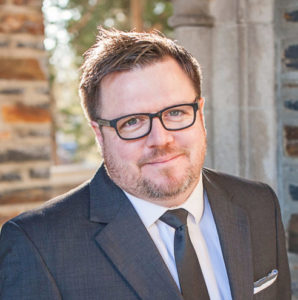Every Christian I know longs for a return to pre-COVID congregational life. For four months, our beloved rhythms have been on hold, leaving us frustrated, exhausted and ready for the widespread acceptance of practices to help curb the spread of the virus. As time moves on, conversations devolve into the either/or of “is the church open or closed for worship?” This dichotomy situates the single collective practice of worship as a problem to solve rather than a solution to be embraced — and this misses the larger point.

Chris Aho
Casper ter Kuile writes in The Power of Ritual: “Where religious institutions have been mistaken … is that they have fallen in love with a specific solution, rather than forever evolving to meet the need.”
Imagine you own a shop or restaurant. What might the mission of that business be? A children’s boutique might “provide unique, high-quality clothing at a fair price.” A restaurant might “provide joyful experiences around amazing food for all who visit.” In both these cases, COVID-related closures throw a wrench in the execution of a business’ mission. But does it change the overall vision? Although it’s near impossible for a closed store to provide high-quality clothing at a fair price or a closed restaurant to facilitate joyful experiences, simply re-opening doesn’t solve the real problem.
One problem caused by COVID-19 is the loss of revenue. The clothing boutique doesn’t succeed by being open; it needs to sell clothes. A restaurant does not thrive by unlocking the doors; it must sell food. Both businesses generate revenue while fulfilling their mission, but simply re-opening is not enough. Operating hours are a pathway to generating revenue but do not guarantee cash. Businesses generate revenue by meeting needs, which explains why businesses work overtime to do more than unlock the doors.
“Maybe the zero-sum discussion of open/closed, streamed and socially distanced corporate worship is not enough.”
These days, stores and restaurants continue to design new pathways to generate revenue to fulfill their mission while working toward their vision. These pathways include online ordering, curbside pickup and local delivery. It’s happening all around us, but what does that mean for churches? Maybe the zero-sum discussion of open/closed, streamed and socially distanced corporate worship is not enough.
Embodying a congregation’s mission and vision must be more involved than that whether we record worship, stream worship or meet out on the lawn. The vision statement of my church is “Loving God, Loving Others, and Serving All.” But the mission is not “to worship on the corner of Main and Spring at 11:00 every Sunday.” We do not exist to “support a staff of five people who keep an office open 35 hours a week.” And the purpose of our shared life is not “to keep people from going to the beach, lake or mountains on Sunday mornings.”
The vision of Oxford Baptist Church is to help all who join our shared life to “Love God, Love Others, and Serve All.” COVID-19 does not change that, and opening our sanctuary doors alone will not fulfill that vision.
Worship — like Sunday school, service auxiliaries, pastoral care, outreach ministries, camps, mission trips, choirs and Wednesday night suppers — is a mission-aligned pathway that leads to our vision of helping people. But opening one beloved pathway does not guarantee we will fulfill our mission or vision any more than opening a boutique or restaurant guarantees financial viability.
“Opening is not the problem. Opening is never the problem to be solved.”
Opening is not the problem. Opening is never the problem to be solved. Opening provides a pathway toward mission and vision. And within that framework, worship is one mission-driven solution.
Oxford Baptist Church gathers for worship to help us all learn to love God, love others and serve all. Worship exists to bring us closer to God in ways that help us fulfill our vision as God’s people. But opening for in-person services alone does not guarantee we will achieve that vision.
The real question every congregation faces is this: “How might we best fulfill our mission and vision even though COVID-19 prevents us from doing things the ways we have always done them?”
That is the question. Unfortunately, I believe that is why many would prefer to argue about whether it is safe for us to gather for worship. To only ask, “Can we worship in person or not?” avoids the complexities of our call. An open/closed debate enables battles with strawmen about germs on doorknobs while we sit out the summer, deferring only to “the numbers.” In this scenario, we are no better than the Muppets Statler and Waldorf in the balcony, shooting down every idea that doesn’t fit our side of the argument.
Congregations need to design practices and pathways to fulfill mission and vision, since many of the pathways we used in February are temporarily closed. While I certainly pray those worn paths will reopen — and I pray every day it will be sooner than later — that is not my only prayer. I also pray we might generate pathways to fulfill our congregational mission and vision beyond gatherings in the sanctuary.
In that prayer and practice, I believe we approach the right problems because worship is not a problem, it is merely one pathway to fulfilling the church’s mission.
Chris Aho serves as pastor of Oxford Baptist Church in Oxford, N.C. He earned a bachelor’s degree in religion from Baylor University and the master of divinity degree from Duke Divinity School.
